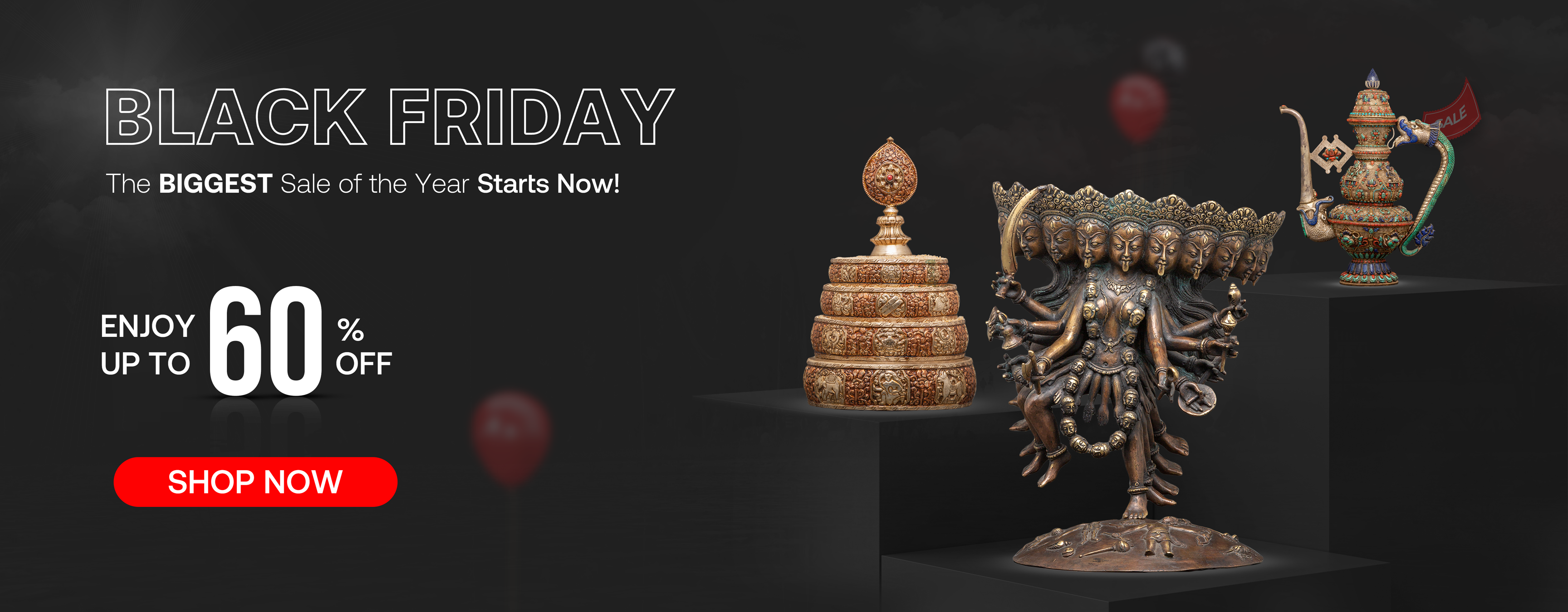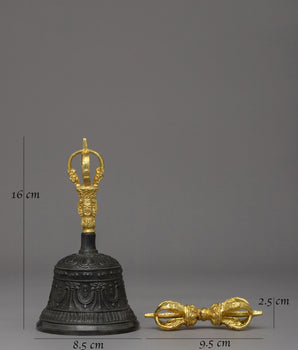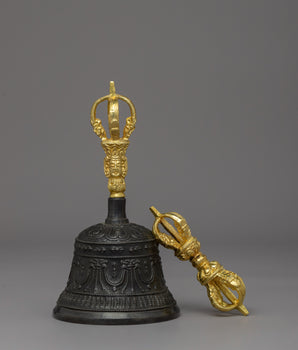A Portable Shrine to Ground Your Practice Anywhere
In modern society, where mobility, minimalism, and spiritual carrying capacities often inform our lifestyle choices, the Portable Tibetan Altar Box has become a relevant and meaningful object for many Buddhist practitioners. These altar boxes serve as tangible reminders of one's intention to cultivate meaning, purpose, and the capacity for learning positive karmic attributes. Central to this is the practice of following us wherever we are in the three jewels, regardless of where those stalls may be, which hinges on the value of carrying meaning and purpose wherever we are. As practitioners, we also exist as a catalyst for learning positive karmic qualities. As practitioners we can "stay" within a respectable distance of the three jewels, whether we are: monks or nuns in travels teaching sangha; lay-practitioners in large urban areas navigating high-risk environments; practitioners going on retreats for mindfulness time; whatever our reasons are for participatory non-participation and non-temporally arise enabling makings of devotion, rituals, and protective definitions that help navigate our situations in the relational past of the portable three jewels.
What is The Portable Tibetan Altar Box?

The Portable Tibetan Altar Box, also known as a Ghau Box or Tibetan shrine box, is a portable and usually handmade container for sacred Buddhist objects. Designed for use by both Tibetan monks and lay practitioners, the Tibetan Altar box serves as a mini-shrine, allowing individuals to engage in their spiritual practice anywhere they may wish. Practitioners may use it to house, for example, small statues or thangkas depicting an enlightened being, usually either Buddha Shakyamuni, Tara, or Padmasambhava, as well as a prayer wheel, mala beads, incense, offering bowls, butter lamps, sacred texts, known as mantras, and ritual implements like bells and dorjes. It can be as small as the size of one's palm or large enough to accommodate the requirements of retreat usage. Each is a functional representation of a practitioner's spiritual devotion, but also a way of incorporating and establishing the sacred into their mundane life.
Historical Background and Spiritual Importance

The portable Tibetan altar box has historical roots deeply ingrained in the nomadic lifestyle and monastic lineage of Tibet. Tibetan monks, yogis, and lay practitioners have traversed the vast and rugged Himalayan terrain for centuries, seeking solace in secluded meditation, pilgrimage, and trade. In culturally mobile lifestyles, the compact and easily portable shrine was not just a convenience, but a necessity. These travelling altars enabled daily practices, such as prayers, offerings, mantra recitations, and visualizations, to be performed uninterrupted, regardless of one's physical surroundings.
Ritual and visualization are paramount in Vajrayana Buddhism, the Tibetan form of Mahayana practice. One more frequently visualizes deities, mandalas, and enlightened worlds than does yogic meditation or sadhana; and possessing a tangible representation of the Three Jewels (the Buddha, the Dharma and the Sangha) allows the practitioner to find a sacred point of focus for their visualizations and deepen meditative absorption when no other living practitioner of Buddhist wisdom is available. Therefore, the altar acts as a 'bridge between the outer ritual and the inner transformation' when we take our practice off the mat and into nature, a tent or cave, and ultimately a space that may be more utilitarian, like a modern apartment.
Additionally, Tibetan altars often included blessed relics, mantras, and images that offered protection and spiritual power. These elements also gave the box its devotional meaning, as well as symbolic guardianship, providing practitioners a sense of safety and sacred presence when traveling or retreating in solitude. Thus, the Portable Altar Box is much more than a holding place for sacred items; it is a living shrine, a portable temple, and a record of the unbroken thread of spiritual practice amidst the movement and uncertainty of life.
Reasons for Having a Portable Altar Box as Buddhist Practitioners

The Portable Tibetan Altar Box is more than a convenience; it is a significant support piece for one's spiritual journey. It is valuable for both experienced practitioners and beginners, providing physical reminders of the spiritual experience of practicing and reinforcing Buddhist values and spiritual practices in a contemporary, mobile lifestyle. Tibetan altar boxes, in particular, serve valuable roles for practitioners. Here are some reasons for consideration for practitioners to have one:
1. Continuity of Practice
In Buddhism, particularly in Tibetan Vajrayana Buddhism, the continuity of practice is crucial for inner transformation. Regularly practicing meditation, mantra recitation, visualization, and the study of the Dharma over time cultivates wisdom and compassion. A portable altar facilitates the continuity of practice, enabling individuals to maintain their practice at any given time in their daily life, such as meditating at a retreat center, chanting mantras while in transit, or offering water and incense at home.
The portable altar serves as a constant spiritual reminder, reconnecting you to your path. Even a few minutes of practice in front of a sacred focal point become instantly more meaningful.
2. Sacred Space Anytime
In a world of constant distractions, noise, and stress, you need to claim at least a little corner of peace. A portable altar is a temporary sacred space that helps you transform an ordinary place into a sacred one for inner work. It can be a hotel room, an office, an airplane lounge, or even the forest. When you open the altar box, you enter a mindful and reverent state of being—a new way of being.
This act of sanctifying space not only enhances your connection to the Dharma, but it also cultivates the habit of intention, indicating that your spirituality is not separate from your daily life, but is deeply intertwined with it.
3. Empowerment/ Blessings
Many Tibetan altar boxes contain consecrated relics, such as small scrolls with handwritten mantras, pieces of cloth blessed by lamas, and miniature statues filled with holy materials. These relics carry the spiritual energy and blessings of enlightened beings.
When you have these in your altar box, you embody a field of protection and positive influence throughout the day. In Tibetan cosmology, this provides spiritual protection from disturbance or negativity while also serving to uplift and energize your practice, making you feel supported and held, even in challenging times.
4. Symbol of Commitment
A Portable Altar Box is a physical representation of your commitment and intention to walk the Buddhist path. It symbolizes a personal commitment to embody the principles of mindfulness, compassion, and wisdom, regardless of one's life circumstances.
Even if you don't have time, just bowing to the altar, picking up the incense, or reciting a brief mantra reinforces your spiritual discipline, helping to keep your practice alive. Over time, your daily engagement with your altar will help instill a sense of self-discipline, reverence, and internal stability. It is not only what you do that matters, but also about ritualizing the act of remembering and returning to your highest potential.
What to Include in Your Portable Altar Box
|
Item |
Purpose |
|
Small Buddha Statue |
Represents enlightenment and serves as a visual anchor |
|
Thangka or Mandala card |
Used for visualization in meditation |
|
Mala Beads |
For mantra recitation and focus |
|
Miniature Prayer Wheel |
Contains thousands of mantras; spinning it is equivalent to recitation |
|
Incense or Butter Lamp |
Symbolizes the offering of light and fragrance to the Buddhas |
|
Sacred Texts |
Recitation of Dharma brings wisdom |
|
Offering Bowls |
Represents generosity, one of the Six Perfections |
Cultural and Artistic Value

A Tibetan altar not only serves a spiritual purpose but is also a lovely representation of Himalayan cultural heritage and sacred art. Each altar is typically handmade by artisans from specific regions, using traditional techniques and spiritual symbolism. These artisans do more than construct receptacles; they cultivate sacred objects filled with devotion and meaning.
Many portable altar boxes are intricately carved, embossed, or painted with Buddhist iconography, with each motif chosen for its spiritual meaning. Some standard features are:
-
The Eight Auspicious Symbols (Ashtamangala): Representing blessings, harmony, and spiritual attainment.
-
The Lotus Flower: Symbolizing purity, spiritual awakening, and the ability to rise above worldly suffering.
-
The Vajra (Dorje): Signifying indestructible truth, and the union of wisdom and compassion.
These are not mass-produced souvenirs but instead, sacred art that preserves the aesthetic, philosophical, and devotional traditions of Tibetan Buddhism. For both practitioners and collectors, a portable altar box serves as a source of spiritual function and cultural significance.
Choosing the best Portable Altar Box

- Portability and Size: Pick your size for your lifestyle. Small boxes are ideal for on-the-go lifestyles, participatory minimalism, and more. Larger boxes work better if you'll only use them at home, or are on longer retreats.
- Material and Craftsmanship: The altar boxes are made up of wood, metal, fabric, or leather. Wood is warmer and traditional, whereas metal is meant to be durable and has some ornamentation applied. Fabric and leather are for lightweight practice, and point you elsewhere for the desired aesthetic and spiritual preferences.
- Interior Components: Made up of compartments, padded sections, or fold-out panels that have clasps or other anchors. You can safely stow statues if that's how you feel; incense is entirely dependent on compartment design, mala beads, and any number of other ritual items.
- Spiritual Blessings: Some of these boxes come pre-blessed and might be infused with limited information, such as relics or dedicated sheets of sacred scrolls. If you can't find one like this, consider having your altar box consecrated by a lama or at a local Dharma center.
- Beginner- Friendly Options: A simple cloth pouch containing the image of the Buddha, along with enough random contents to suffice as an offering, can be a good start if nothing else. There is some merit to that: sincerity in contrivance and sacrifices make a better outcome.
Conclusion: A Sacred Center in a Busy World
The Portable Tibetan Altar Box is more than just a travel accessory. It’s a personal refuge, especially if you move around a lot and want to support an identified spiritual practice, wherever you are globe-trotting. It helps you maintain a connection to the Three Jewels, regardless of whether you're traveling on retreat, taking public transportation, or finding a moment of solitude in a busy world, which honors mindfulness, devotion, and discipline.
The Portable Tibetan Altar Box offers space, adornment, resonance, and wonder. It is an object infused with cultural and traditional practices and meanings, providing visual stimulation, aid towards protection, inspiration, and the continuity of practice. For any Buddhist practitioner, whether beginner or advanced, this simple little shrine may be life-changing, as it serves to remind practitioners that the sacred is always close, even in the most ordinary of moments.















